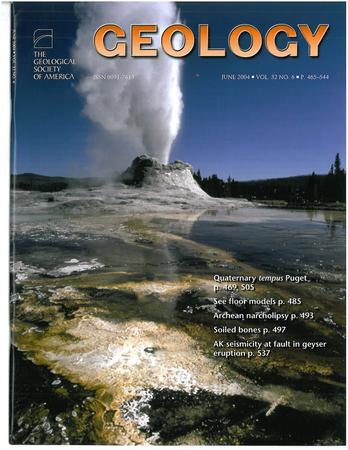活跃期El Niño -类似南方涛动- 1.2亿年前的年际变率
IF 4.6
1区 地球科学
Q1 GEOLOGY
引用次数: 0
摘要
El Niño−南方涛动(ENSO)是年际气候波动的主要模式,产生影响当今全球气候变率的遥相关。它在过去温室气候中的行为为理解全球变暖下未来ENSO提供了有用的视角。尽管自晚白垩纪以来每年都有ENSO活动的地质证据,但早期温室期的ENSO活动却很难得到解决。在这里,我们提供了来自中国东北湖泊沉积物的证据,显示了120亿年以前的年际降水变率信号,主要频带为2 - 5年。早白垩世的耦合气候模拟产生了类似enso的变率,热带太平洋海面温度和大气与东北降水的远相关具有相似的2 - 5年周期性。与现代ENSO相比,早白垩世ENSO样变率表现出更高的频率和更强的幅度,类似于对未来ENSO演变的预测。本文章由计算机程序翻译,如有差异,请以英文原文为准。
Active El Niño−Southern Oscillation−like interannual variability 120 million years ago
The El Niño−Southern Oscillation (ENSO) is the dominant mode of interannual climate fluctuation, generating teleconnections impacting global climate variability today. Its behavior in past greenhouse climates provides a useful perspective for understanding future ENSO under global warming. Despite annually resolved geologic evidence of active ENSO since the Late Cretaceous, ENSO operation at earlier greenhouse periods is poorly resolved. Here, we present evidence from annually resolved lacustrine sediments in northeast China showing signals of interannual precipitation variability 120 m.y. ago, with major frequency bands of 2−5 yr. A coupled climate simulation of the Early Cretaceous generates ENSO-like variability with similar 2−5 yr periodicities in tropical Pacific sea-surface temperatures and atmospheric teleconnection to northeast China precipitation. The Early Cretaceous ENSO-like variability shows higher frequency and stronger amplitude compared to modern ENSO, resembling predictions of future ENSO evolution.
求助全文
通过发布文献求助,成功后即可免费获取论文全文。
去求助
来源期刊

Geology
地学-地质学
CiteScore
10.00
自引率
3.40%
发文量
228
审稿时长
6.2 months
期刊介绍:
Published since 1973, Geology features rapid publication of about 23 refereed short (four-page) papers each month. Articles cover all earth-science disciplines and include new investigations and provocative topics. Professional geologists and university-level students in the earth sciences use this widely read journal to keep up with scientific research trends. The online forum section facilitates author-reader dialog. Includes color and occasional large-format illustrations on oversized loose inserts.
 求助内容:
求助内容: 应助结果提醒方式:
应助结果提醒方式:


